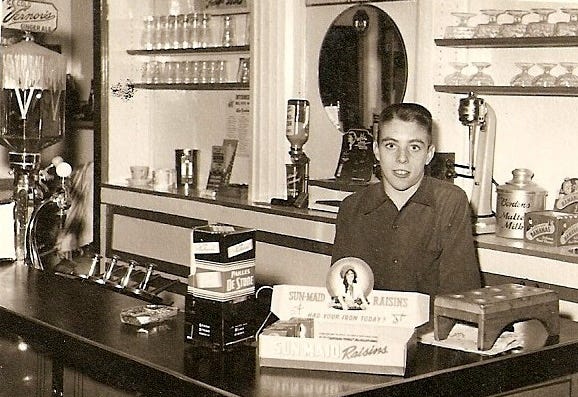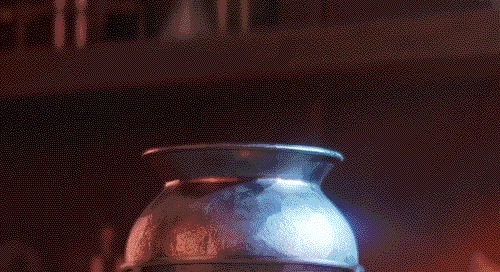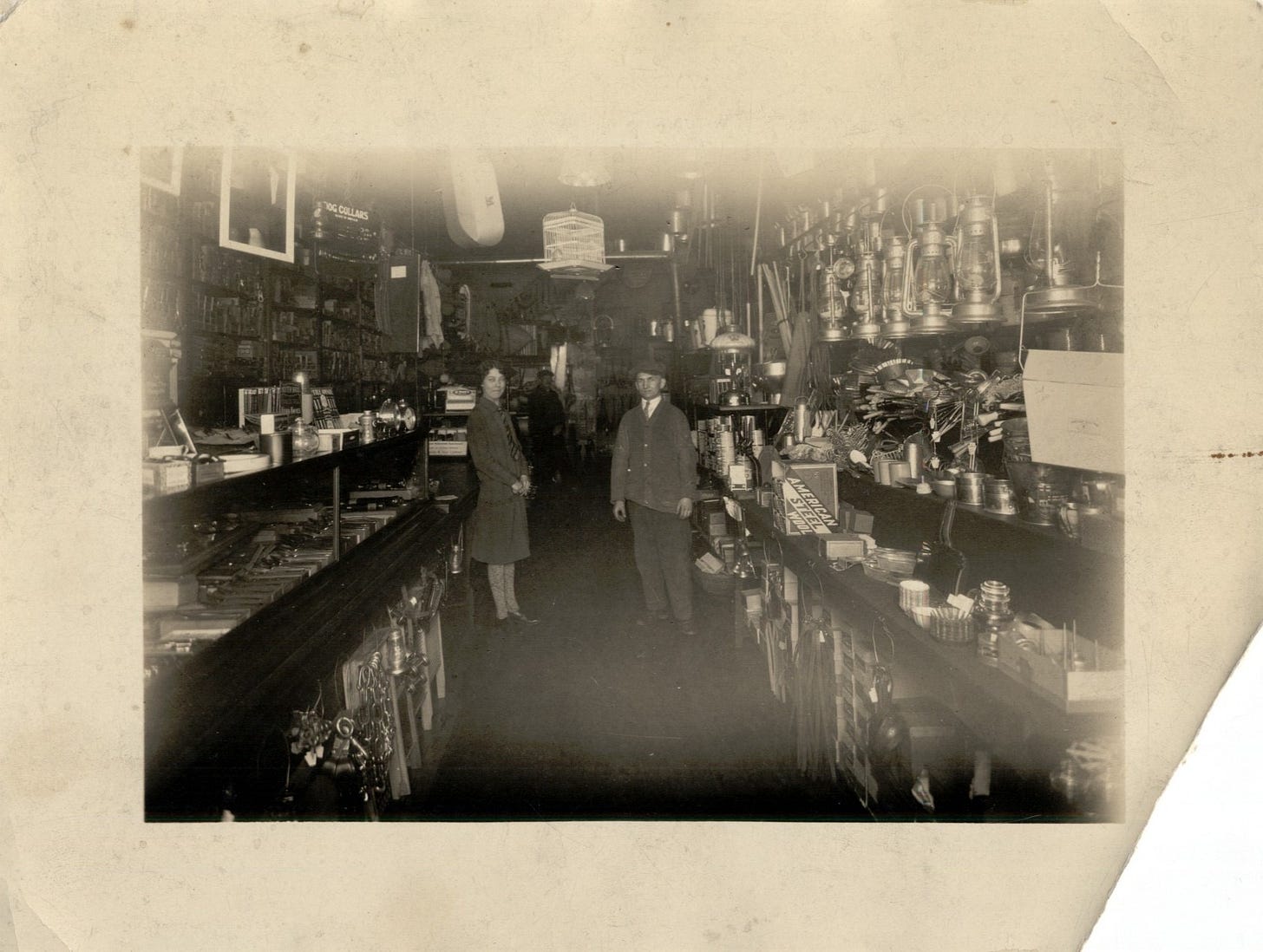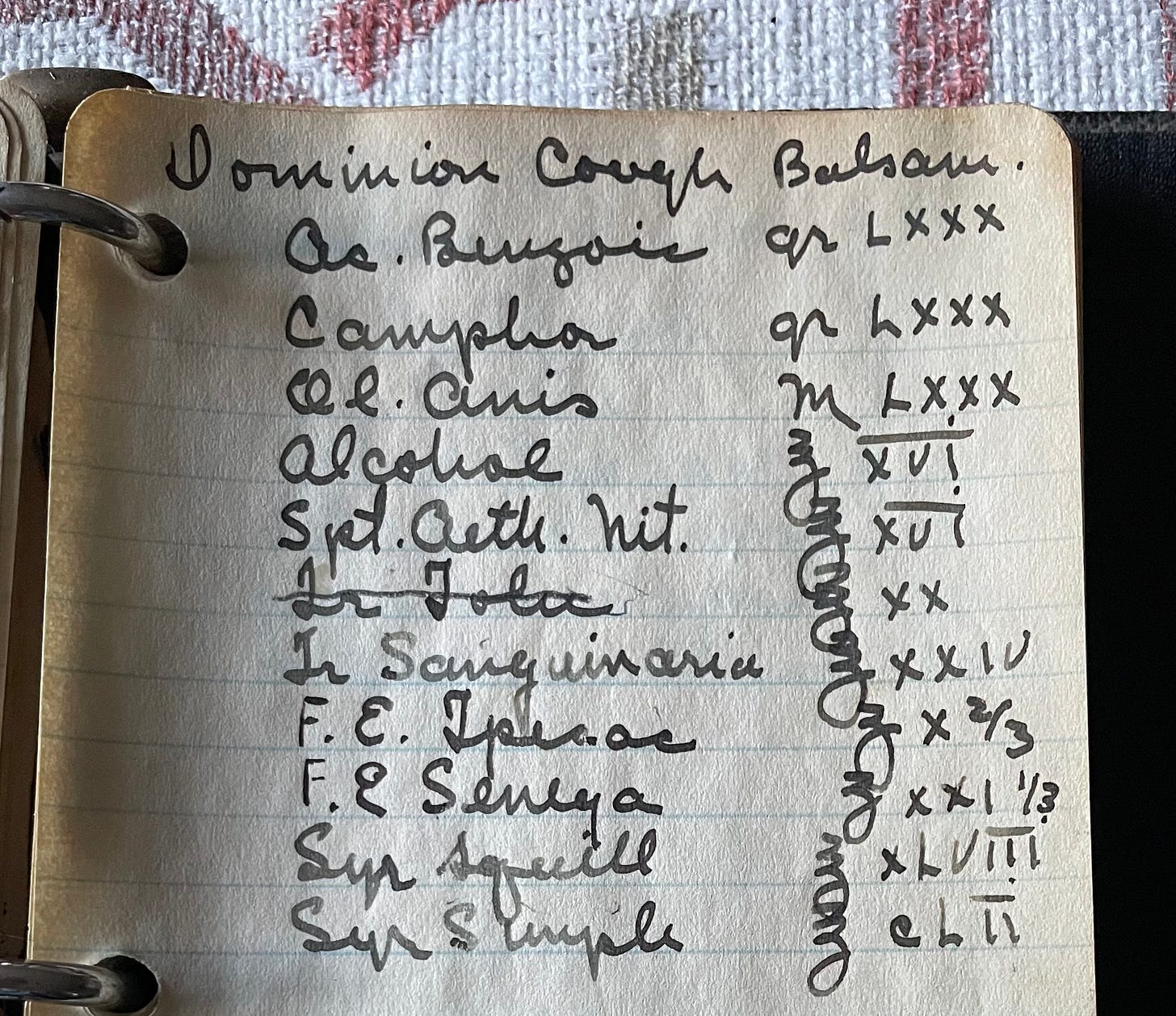Among a spooky story’s cast of characters, it’s not unusual to find a mixer of elixirs, for purposes noble or nefarious. Clad in robes, consulting ancient texts written in a scrawling hand, the mysterious figure pinches a bit of this and that to add to a nearby bubbling cauldron. A cloud of smoke, and a new potion is ready to enchant.
And when I came across the ephemera of my great-grandfather’s life as a small-town drugstore owner, it was not hard to feel like a descendant of such a mystical medicine man.
Spreading His Magic
Delhi (pop. 4,2401) is a small town in southern Ontario and the “Heart of the [former] Tobacco Country”, where it produced about 90% of Canada’s tobacco. And on the main drag of the town, King Street, sat Hamilton Ross’ drug store until the late 1950s. The building still stands today as the Delhi Sub Shop.
To be a pharmacist in the early to mid-20th century was a relatively unstandardized affair; Hamilton was registered with the Ontario College of Pharmacy (with the $10 registration fee), but how he came about the profession, is not in our family records.
Where in some provinces, pharmacists could train at universities, in others, such as British Columbia, they could only train by apprenticeship with additional formal instruction from certain pharmacy schools. The Canadian pharmacy system lacked standardization beyond 12 stringent licensure exams, which focused mainly on a pharmacist's manufacturing and compounding abilities.
History of Faculty of Pharmaceutical Sciences (UBC)

The Rosetta Stone for Reading Apothecary
Historically, the term “apothecary” referred to both the person who manufactured and dispensed medicines (lowercase “a” for our purposes), and the shop in which those medicines were sold (capitalized “A”).
The Evolution of the Apothecary for the Apothecurious (Wust, 2017)
Aside from the building proper and a handful of photos, one of the few things remaining of Hamilton’s legacy as a druggist is a small leather three-ring binder. The front contains lettered dividers and empty pages, until you reach the back pages. There, pages of apothecary formulae for man and beast are stored - some in the ink of a calligraphy pen, others neatly typed. (Coincidentally, Mark of How About This has a fun post about cursive, hand-printed, and typed text.)
It’s been a puzzle to decipher his writing sufficiently to then search the meaning of these abbreviations, symbols and Roman numerals. During his tenure, Hamilton would have used the Apothecary system of notation. The base amount for dry measures appears to be the grain, where 1 grain (gr) equaled 64 milligrams (mg); from here, we have larger, even more whimsical-sounding amounts23:
20 grains = 1 scruple (℈);
3 scruples = 1 dram (ʒ);
8 drams = 1 ounce (℥);
12 ounces = 1 pound (℔).
There is also the existence of the minim (M or ♏︎; equivalent to one drop of water), which is the liquid equivalent to 1 grain (dry).
The amounts of grains and drams needed for a medicine were written in Roman numerals (with the exception of ss, which denoted half-measures). A line over some of the numbers means to multiply those numbers by 1,000 (although we will see in a minute why this is problematic).4
With the code partially cracked, I was ready to jump back into Hamilton’s book of spells.
Uncovering the Medicine Show
Not one for half-measures (or ss-measures), I picked a particularly meaty recipe to decipher - the “Dominion Cough Balsam” recipe. How did one treat a cough 70-80 years ago?
Well, if I’m reading this right, with a lot of alcohol.
Ac. Benzoin grLXXX = 80 grains of Ac. Benzoin
While benzoic acid is derived from benzoin resin, I’m guessing this is referring to the acid, which is a food preservative.
Camphor grLXXX = 80 grains of camphor
An anti-tussive (reduces or prevents coughing).
Ol. Anis MLXXX = 80 minim (drops) of anise oil
Anise (liquorice) is an expectorant (i.e., helps loosen and bring up gunk in your lungs) but maybe it was also a flavouring?
Alcohol ℥X̅V̅I̅ = 16,000 ounces of alcohol (?!)
Okay. You’ve seen the inside of that store. Hamilton barely had room on the shelves for his wares; the idea of storing industrial size drums for mixing his medicines doesn’t fit. After frantic searching in my cipher, and some math on the back of the napkin, I think found my error.5
Onward.
Alcohol ℥X̅V̅I̅ = 16,000 ounces of alcohol
Likely the solvent for this whole concoction.
Spt. Aeth. Nit. ℥X̅V̅I̅ = 16,000 ounces of spirit ether nitrate
Spirit of (a)ether nitrate was the first anesthetic.6
Tr Sanguinaria zXXIV = 24 ounces of Bloodroot tincture
An emetic and respiratory aid, the juice was also used for coughs and sore throats.
F.E. Ipecac ʒx2/3 = 10 and two-third drams of ipecac fluid extract.
Also an emetic, fluid extracts were far stronger than the syrup form. I’m now starting to re-think the large quantities of solvent, given this fact; the fluid extract perhaps required a large base to avoid poisoning.
F.E. Senega ʒXXI1/3 = 21 and one-third drams of snakeroot fluid extract.
Another “stimulating expectorant” that could also help sore throats and other aches.
Syr. Squill ℥XLVI̅I̅I̅ = 3,045 ounces of squill flower syrup
A flower that relieves edema and thins mucus.
Syr. Simple z cLI̅I̅ = 2,150 ounces of sugar water
The tasty simple syrup one uses for cocktails. And, given the amount of mind-altering substances in this, it seems appropros?
Toil and Trouble
As I mentioned earlier, there are more pages in this tiny tome that I’ll decipher because I’m a massive geek for fun. It’s a curiosity, and to compare this to how science has evolved over time is fascinating to me.
It was frustrating at times, though, to find reputable sources for the above links. A number of the herbal components of his cough balsam are now relegated to the “natural medicine” shelves of Amazon, and it’s not regulated in the slightest. That, to me, is the spookiest part of these remedies; for, while there may be some innate benefits to these extracts and oils, the evidence is not well established. “Natural” doesn’t mean the substance won’t interact with your body and any medicines you may already be taking. Be extremely cautious (or, steer clear entirely), without consulting a reputable medical professional.
Having said that, the other cough remedy in Hamilton’s book is primarily composed of the juniper extract known as gin. I think I can get behind that particular tonic.
Thanks for reading today’s post, the last in my spooky science series. If you’re interested in reading more science-related content, please consider subscribing to receive weekly posts in your email or Substack app.
Source: Census Profile, 2016 Census.
Strangely, he seemed to use the “Pre-Imperial” British Apothecary system, judging by the use of ℥ and not oz.
I don’t recall learning that in math class?
Hamilton used the British Apothecary system. In Footnote 3, the last page shows equivalency tables of British Apothecary to more familiar measures. In this table, 8 ounces = 28.41mL. In 16,000 ounces, there would be “2,000” of these 28.41mL, which would equal 56,820ml, or about 56 litres. Still a lot (basically, a keg), but far more plausible?
If these are indeed the correct proportions of alcohol and ether, you are indeed not feeling any cough. Or, really, much else. Mission accomplished?









I’ve really enjoyed this spooky science series, and yes, you ARE a massive geek. 😀
Love old apothecaries and wonder what benefits I am missing out, missing a tincture of this or dram of that! How cool is the picture of you great uncle, Gavin back in the day. A great read, Bryn Thanks always for the deep dive!